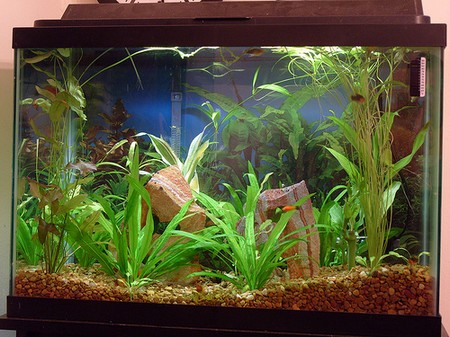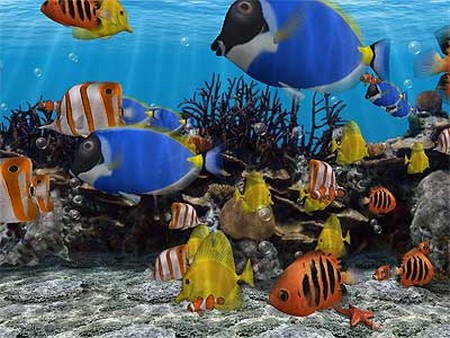With the wide range of formulated foods available nowadays, including general-purpose diets as well as specialist kinds for different fish groups, feeding aquarium fish has become relatively easy. Many live foods may also be obtained fresh, freeze-dried, or frozen, but if you prefer, you can grow your own for a ready fresh supply.
Digestion and feeding habits
Fish have a range of feeding habits, so find out how the species you intend to keep would normally eat in the wild; this enables you to meet their needs as closely as possible. The two main groups are herbivores and carnivores, but within these divisions there are numerous other preferences and habits.
Take care not to overfeed your fish, because uneaten food may contaminate the water. Feed them little and often – two to three small amounts each day, with the final feed last thing at night if you have any nocturnal species. In a community aquarium, also take account of which levels the fish inhabit – providing floating foods for surface-feeders and sinking ones for bottom-dwellers.
The digestive system
There is a key difference between most species of tropical aquarium fish and cyprinids, such as barbs and danios. Unlike other fish, cyprinids have no stomach; instead, the first part of the intestinal tract can be distended with food, until it is digested through the tract.
Cyprinids use their pharyngeal teeth, located at the back of the throat, to grind food morsels into smaller particles, so they can swallow it. The food travels down the oesophagus into the intestine, where an enzyme called trypsin helps digest protein, Other fish also use pepsin, produced in the stomach, for this purpose.
Enzymes and bile enter the digestive tract at the end of the oesophagus. This does not occur in fish with true stomachs because the stomach acid would inactivate these enzymes. In cyprinids, this mixing of enzymes and food for a long period improves their digestive efficiency, so that they can derive the maximum benefit from the available nutrients.
Breakdown of foodstuffs
In cyprinids, these chemicals start to act on food stored in the intestinal sac. Some enzymes assist the uptake of protein, while others help to break down carbohydrate, converting it into the fish’s main source of energy. Bile assists in the breakdown and absorption of fats.
Protein in the diet is important for growth, and it can help trigger spawning behaviour in adult fish. Fats provide a good source of energy, and are a key component of cell membranes, as well as aiding the manufacture of hormones.
The length of time taken for food to pass through the fish’s digestive tract is influenced by the temperature of the surroundings, and the length of the tract itself.
- Carnivores • Carnivorous fish have a short intestinal tract, because they can absorb nutrients very efficiently; this is partly due to the production of collagenase, an additional enzyme which assists with the breakdown of animal protein.
- Herbivores – Herbivorous fish have long digestive tracts so they can digest and absorb the nutrients from their vegetarian diet, because there is considerably less protein in this type of food.
Feeding habits and preferences
In a community aquarium, you will probably have to provide a range of foods to suit different fish, even within a group, fish may have different needs. Rift Valley cichlids, for example, have remarkably diverse feeding habits although they inhabit the same environment. This enables them to survive at much higher densities than they could otherwise, simply because they do not compete with each other for a single food source.
In Lake Malawi alone, there are more than 400 species of cichlid. Some are herbivorous, others predatory, and there is considerable diversity within these categories. Certain vegetarian species graze on algae found on rocks by the lake shore, while others feed on plankton in the water, or consume larger plants. Insects are a major part of the diet for other cichlids in the lake, while some are active hunters and will cannibalize their own kind.
Suitable foods
Consider not just which type of food the fish eat, but also how they obtain their food. If you provide small worms for hatchetfish, for example, you need to put the worms in a floating holder to keep them near the surface, or they will sink. Hatchetfish feed at the surface and rarely venture down to the lower reaches for food, any more than Corydoras catfish will scout at the surface. Look out for special foods designed to meet the specific dietary preferences and feeding habits of different fish, such as foods that sink to the bottom of the aquarium which are suitable for catfish.
Watch for predators
A fish’s shape gives an indication of its feeding habits: for example, predatory catfish are typically much more streamlined than their bottom-dwelling cousins, a sign that they swim fast to hunt prey. There are exceptions, however: some predators are relatively passive and use camouflage to lure unsuspecting prey within reach.
Obviously, do not mix fish that might prey on each other. When adding new fish, investigate not just their potential size, but also their feeding habits. Remember, some fish hunt only at night, so you may not realize their predatory nature until you notice that one or more of their companions has disappeared in the morning!

